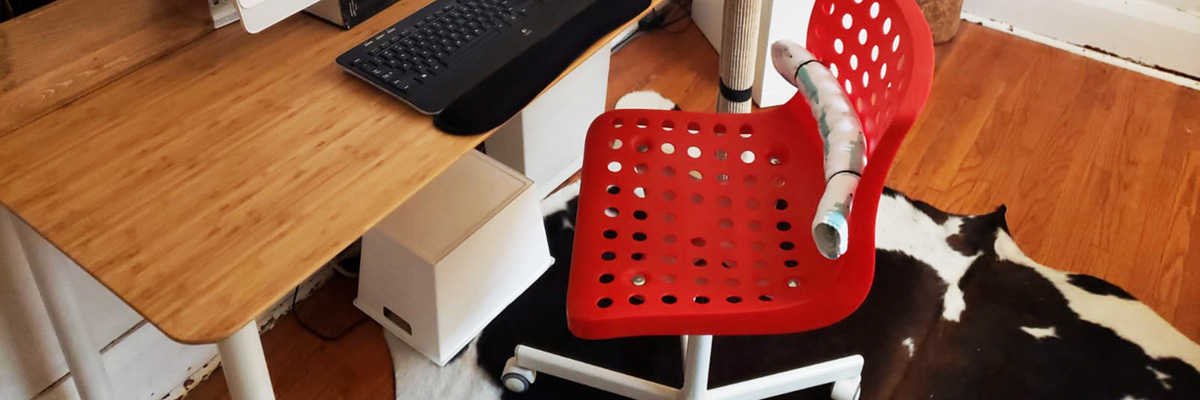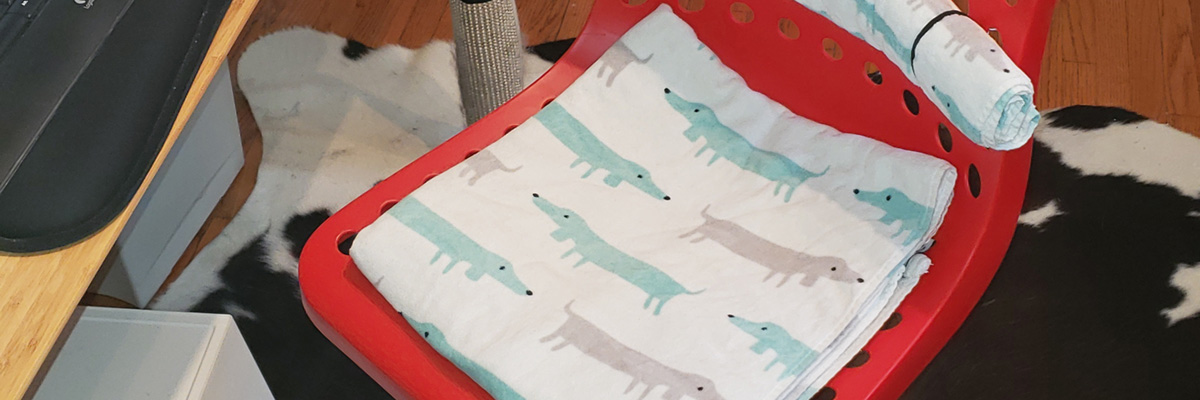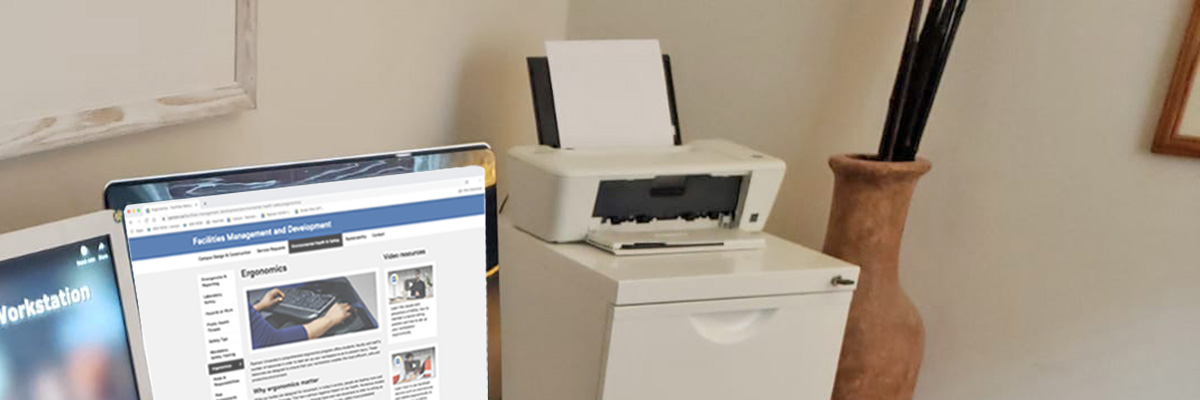How to Create an Ergonomic Setup
In order to prevent strain and injury, review these tips that can improve your workspace.
Getting started
Check out the resources on our ergonomics website to get started, in particular the videos on:
- setting up your desktop or laptop ergonomically (external link) ,
- working ergonomically with handheld devices (external link) and
- Musculoskeletal injury prevention strategies (external link) , including stretches you can do on your own.
While an ergonomic setup is certainly important, what’s crucial is that you’re remembering to move every 20 to 30 minutes for 20 to 30 seconds.

Your chair
Ideal conditions
- Ideally you want a chair with adjustable height, with both armrests and a backrest. Sit back in your chair with your knees bent at 90° when your feet are flat on the floor
- Take breaks from sitting every 30 to 60 minutes to let your body switch positions.
How you can improvise
- Find a chair that has a firm back.
- Use a thin pillow or folded towel to provide additional cushion for your seat pan, making it comfortable for longer periods of sitting. Stools are not only uncomfortable for extended periods of time, they lead to hunching and slouching forward, promoting poor posture and back pain.
- If your chair has inadequate back support, roll a hand towel and use it to support the natural curve of your lumbar spine. Elastics easily keep the towel rolled nice and tight. Twist ties can be used to secure the towel to the chair.
- If your feet don’t reach the floor, use a tupperware bin upside-down or a stack of heavy books as a footrest.
In the event that you require a new chair, employees and their manager are invited to choose one which meets the (google doc) university’s specifications (external link) , which are based on ergonomic standards from a catalogue of 11 different types of office chairs. Each of these chairs comes in various colours and sizes, and includes a video that shows how to adjust your chair. Additional customized support is also available from the vendor if required. Please refer to the university’s Vendors of Record & Common Purchases for a list of suppliers.

Your work surface
Ideal conditions
- Ideally the height of your work surface should be slightly below your elbows. You want to ensure you’re sitting with your shoulders relaxed and elbows in a 90° position.
How you can improvise
- If the work surface isn’t below your elbows, raise yourself up if possible by using a higher chair, while still maintaining the 90° knee position. If you don’t have a higher chair, use a thin pillow or folded towel to provide height for your seat pan.
- Find alternative spots for periodic standing workstations such as a dresser or ironing board.

Keyboard and mouse
Ideal conditions
- Have an external keyboard and mouse as this helps promote a neutral body posture by allowing you to place these in the most comfortable locations. Tablet cases that come with an external keyboard and mouse are handy but keep in mind that the screen height can be too low for an ergonomic setup.
How you can improvise
- Consider learning shortcuts on your keyboard to reduce the frequency with which you use the mouse.
- When the ideal workstation height can’t be achieved, use gel pads or a rolled towel under your wrists to help reduce contact stress of your wrists against the table.

Monitors
Ideal conditions
- The top of your monitor should be at eye level and an arm’s distance away.
- If using two monitors, they should be placed side by side to prevent awkward postures.
- Adequate brightness and contrast to prevent eye strain.
How you can improvise
- Raise the height of your monitor by placing it on top of a stack of books or laptop stand.
- Natural daylight has its benefits but angle your window blinds to prevent glare on your monitor. Task lighting like a table lamp or floor lamp can be used to improve low-light areas.
- Consider the adjustments that can be made directly to your screen:
- Monitor brightness and contrast: Adjust to match the brightness of the room.
- Display quality: Adjust the resolution (the higher the better i.e. 800 x 600) and refresh rate (70 Hz or higher to reduce flickering).
- Font size: Adjust to a size that reduces eye strain, depending on your eyesight and prescription.
- If you’re accustomed to using two screens at work, try to find a spare monitor or TV that can be used for a dual screen if you’re able. Depending on your preference, one monitor should be primarily used for task focused, frequent items such as working on presentations or sending emails whereas the second monitor is for infrequent use such as displaying calendars or your inbox.

Other considerations
- Incorporate stretches into your daily routine or during long meetings!
- Where possible, try to end meetings a little early to allow participants an ergo-break between video calls.
- External printers should be situated away from the workstation to prevent overreaching and to encourage you to take microbreaks.